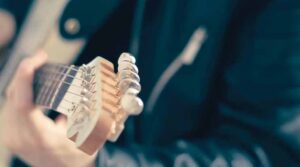Vibe, function, and sound. I just can’t decide.
Whenever you’re out seeing some of our great Key West musicians, you’ve most likely seen a lot of guitars and basses up on the stage. Some players have two or three instruments with them (unless they’re the immensely talented Jillian Todd, who once took the stage with 13, yes 13, beautiful guitars — and played them all.)
But why does an artist bring more than one, and how do they decide which is right for the job?
While I’ve never matched what is certainly a Key West record of 13, I do own 13 basses and each one has seen action on a Key West stage. What factors does an artist consider when deciding what goes in the truck before a gig? Sure, we might want a backup, but we don’t just grab whatever is closest. It’s a multi-variant decision that is purposeful but quick, intuitive and deliberate, and based on years of experience. That decision is based on three factors: vibe, function and sound.
VIBE • We all want to project a vibe when we’re onstage. Projecting a cool vibe enhances the audience’s experience and makes the gig more fun. Do we want to be vintage, wild, fun, crazy or serious? Jazzy, smoky or rockin’? The choice of instrument can reflect those things.
Whether it’s me stepping onstage with my vintage 1963 Fender Jazz Bass, or Larry Baeder ascending with his vintage 1959 Fender Telecaster, each projects a different look and feel. And each creates a different vibe with the audience. To project something totally unique, I might bring my big acoustic bass onstage and play with the bow (you ain’t heard nothing until you’ve heard that low E with a bow through 1200 watts). And nothing screams “ROCK AND ROLL” more than Ross Brown showing up blazing with his Ibanez Destroyer.
FUNCTION • Aside from looking cool, instruments fulfill a specific function within a band. If I’m playing a jazz show at the Little Room with Claire Caplan, I always play my upright bass. It has a low-end punch that is more drum than guitar and lays down a pulse that’s perfect for bebop and swing.
If it’s funk you want, I sling on my Music Man Stringray (“the funk machine”) because nothing is better for that sharp metallic tone you hear when the bass player “slaps” his bass — something you hear at virtually every funk show. Note: I’m more of a Rocco Prestia (Tower of Power) fan, so I don’t slap much, which is why you almost never see my ‘Ray onstage.
If a gig calls for a wide variety of styles, then I need a chameleon, a bass that sounds just as great on a Bob Marley song as it does on one from the Police. Whether it’s funk, rock, soul, reggae or grunge, you can’t beat the Fender Jazz bass, which sounds equally good in the studio as it does onstage.
If you’ve got a hankering for country, my Carvin six-string is the rodeo king, with its “woody” tone and satisfying low B string that I need to hit at just the right moment. Or I might pull out my Electric Upright Bass (EUB for the cool kids), a perfect hybrid that bridges the gap between an upright bass and electric.
Some basses have four strings, some five and others six, although one player in town has a NINE-string bass. More strings give you more options, more notes and different sounds. It all depends on the music. I’m more traditional, and though I own five- and six-string basses, I usually play a four.
SOUND • In the end, vibe and function won’t quite get you there. Sound quality is the priority, and three basses are the undisputed champions: the Fender Jazz bass, the Precision bass and the acoustic upright. The Jazz bass can cover any style and sound great. The Precision excels at rock and soul. And the upright bass always sounds cool and oh so fat.
In the electric bass category, there are two sub-categories: fretted and fretless. If there is any chance for funk, I’ll usually select a fretted jazz bass, but there is nothing like the fretless jazz bass when you need it. It has a slidey-smooth sound of its own, and is especially great at modern jazz, a la Weather Report or Jaco Pastorius. I had a chance to pull out my 1963 fretless jazz last season for Jillian’s Joni Mitchell Celebration and the sound perfectly matched the music (not to mention it was the same exact year and model bass used by Jaco Pastorius on “Shadows and Light”).
So the decision to choose a bass (or any other instrument) isn’t random. We all have our reasons, with function and sound being the most important — but we also want to look cool doing it.
Jeff Dalton moved to the Florida Keys with his wife Patty in 2016. He is active in the Key West music community as a bass and piano player and music director. In 2023 he opened Sunrise Studios of Marathon, a music school and recording studio for all ages, and is working as a producer and engineer on projects with artists from the Keys, Southwest Florida and Detroit.



